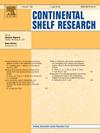在过去的100年里,斯卡格拉克盆地的物质堆积率下降了
IF 2.2
3区 地球科学
Q2 OCEANOGRAPHY
引用次数: 0
摘要
自19世纪以来,北海沉积物系统一直受到动态水文制度和强烈的人类改变的影响。斯卡格拉克是来自北海的悬浮沉积物的最大沉积中心。因此,斯卡格拉克的沉积物为北海沉积物循环的潜在变化提供了历史记录。尽管Skagerrak的质量积累率(MAR)数据是可用的,但之前的研究主要集中在稳态重建上,对于这些速率如何随时间变化知之甚少。为了解决这一知识空白,我们提出了基于天然放射性核素210Pb和人为时间标记137Cs、现代14C分数(F14C)和汞(Hg)的年龄-深度模型,以确定Skagerrak盆地深处434 ~ 677 m水深的6个站点1963年前后的MAR。由于这一年受到原子武器试验和沉积Hg含量变化导致的沉积物岩心137Cs和F14C峰的限制,我们采用1963年作为边界。初步结果表明,Skagerrak盆地深层的平均MAR从0.17 g cm−2 yr−1下降到0.14 g cm−2 yr−1。通过对数据应用反应输运模型,我们进一步模拟了生物扰动对固相剖面的影响,揭示了当考虑生物扰动时(从0.17 g cm−2 yr−1到0.09 g cm−2 yr−1),MAR的下降更为明显。Skagerrak盆地的MARs下降表明北海沉积物体系随着时间的推移发生了实质性的变化。可能的原因包括北海环流模式的转变、瓦登海沉积物的增加以及河流筑坝、港口航道加深和海岸保护导致的沉积物输入减少。然而,我们强调,我们的数据不允许对沉积物循环的时间变化背后的主要驱动因素进行定量分析。因此,我们建议将我们的结果与Skagerrak沉积物的来源信息结合起来,并将Skagerrak数据整合到考虑北海非稳态粒子传输的更大规模物理模型中。本文章由计算机程序翻译,如有差异,请以英文原文为准。
Mass accumulation rates decreased in the Skagerrak basin over the last 100 years
Since the 19th century, the North Sea sediment system has been subject to a dynamic hydrographic regime and intense human alteration. The Skagerrak serves as the largest depocenter for suspended sediment originating from the North Sea. Thus, deposits in the Skagerrak provide a historical record of potential shifts in the sediment cycle of the North Sea. Despite the availability of mass accumulation rate (MAR) data in the Skagerrak, previous studies focused on steady-state reconstructions and little is known about how these rates may have changed over time. To address this knowledge gap, we present age-depth models based on the natural radionuclide 210Pb and the anthropogenic time markers 137Cs, fraction modern 14C (F14C) and mercury (Hg) to determine the MAR before and after the year 1963 at six stations in the deep Skagerrak basin between 434 and 677 m water depth. We applied 1963 as the boundary since this year is constrained by 137Cs and F14C peaks in the sediment cores due to atomic weapons testing and changes in sedimentary Hg contents. Our primary result reveals that the MAR in the deep Skagerrak basin decreased from 0.17 to 0.14 g cm−2 yr−1 averaged across the stations. We further simulate the effect of bioturbation on the solid phase profiles by applying a reaction transport model to the data, revealing that the decline in MAR is more pronounced when bioturbation is considered (from 0.17 to 0.09 g cm−2 yr−1). Decreasing MARs in the Skagerrak basin indicate that the sediment system of the North Sea substantially changed over time. Possible reasons include a shift in the North Sea circulation pattern, enhanced sediment trapping in the Wadden Sea and reduced sediment inputs due to river damming, deepening of harbor channels and coastal protection. However, we stress that our data do not allow for a quantitative analysis of the major driving factors behind the temporal variability of sediment cycling. Hence, we recommend combining our results with information on the provenance of the Skagerrak deposits and integrating the Skagerrak data into larger-scale physical models that consider non-steady state particle transport in the North Sea.
求助全文
通过发布文献求助,成功后即可免费获取论文全文。
去求助
来源期刊

Continental Shelf Research
地学-海洋学
CiteScore
4.30
自引率
4.30%
发文量
136
审稿时长
6.1 months
期刊介绍:
Continental Shelf Research publishes articles dealing with the biological, chemical, geological and physical oceanography of the shallow marine environment, from coastal and estuarine waters out to the shelf break. The continental shelf is a critical environment within the land-ocean continuum, and many processes, functions and problems in the continental shelf are driven by terrestrial inputs transported through the rivers and estuaries to the coastal and continental shelf areas. Manuscripts that deal with these topics must make a clear link to the continental shelf. Examples of research areas include:
Physical sedimentology and geomorphology
Geochemistry of the coastal ocean (inorganic and organic)
Marine environment and anthropogenic effects
Interaction of physical dynamics with natural and manmade shoreline features
Benthic, phytoplankton and zooplankton ecology
Coastal water and sediment quality, and ecosystem health
Benthic-pelagic coupling (physical and biogeochemical)
Interactions between physical dynamics (waves, currents, mixing, etc.) and biogeochemical cycles
Estuarine, coastal and shelf sea modelling and process studies.
 求助内容:
求助内容: 应助结果提醒方式:
应助结果提醒方式:


